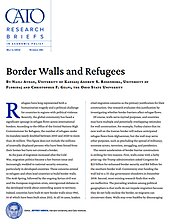Refugees have long represented both a humanitarian tragedy and a political challenge for countries in regions with political violence. Recently, the global community has faced a significant upsurge in refugee flows across international borders. According to the Office of the United Nations High Commissioner for Refugees, the number of refugees under its mandate nearly doubled between 2010 and 2020 to more than 26 million. This figure does not include the millions of internally displaced persons who have been forced from their homes but have not crossed a border.
As the pace of migration increased after the Cold War, migration politics became a hot-button issue and increasingly wedded to national security concerns, particularly in developed countries. These concerns extend to refugees and often lead countries to build border walls. The Arab Spring, followed by the ongoing Syrian civil war and the European migration crisis, reinvigorated debates in the developed world about controlling access to territory. Indeed, countries have built 61 new border walls since 1945, 14 of which have been built since 2012. In all 14 cases, leaders cited migration concerns as the primary justification for their construction. Our research evaluates this justification by investigating whether border barriers affect refugee flows.
Of course, walls serve myriad purposes, and countries may have multiple and potentially overlapping rationales for wall construction. For example, Turkey claims that its new wall on the Iranian border will reduce anticipated refugee flows from Afghanistan, but the wall may serve other purposes, such as precluding the spread of militancy, nonstate actors, terrorism, smuggling, and pandemics.
The recent acceleration of border barrier construction is striking for two reasons. First, walls come with a hefty price tag: the Trump administration asked Congress for $23 billion for enhanced border security and $18 billion for the southern border wall. Controversy over funding the wall led to a 35-day government shutdown in December 2018. Second, most existing research finds that walls are ineffective. The prevailing wisdom among political geographers is that walls do not impede migration because they do not fully enclose the border, so migrants can circumvent them. Walls may even backfire by discouraging return migration and motivating more migrants to apply for asylum. If walls work at all, they do so when reinforced with other measures, such as surveillance, razor wire, heat sensors, movement detectors, drones, and patrol personnel.
Despite these issues, many politicians extol the ability of walls to impede territorial access and tout them as a solution to migratory pressures. Donald Trump argued that a wall on the US-Mexico border was necessary to make it difficult for migrants to enter the United States, and British politicians justified the so-called Great Wall of Calais as the best way to prevent migrants from seeking asylum in the United Kingdom. In recent years, Greece has extended its border wall to deter migrants from entering the European Union. These justifications and the actions based on them assume that border walls work and keep people out despite the cost.
Scholars have made important strides in documenting the ineffectiveness of walls in stemming migration, but much of this research is based on examining certain borders and segments of borders. In contrast, our study uses United Nations High Commissioner for Refugees data on global refugee flows from 1970 to 2015 and data on all border walls built from 1945 to 2015. Our results corroborate the scholarly skepticism over the effectiveness of walls: border fences do not appear to have the effect that leaders frequently use to justify their expensive construction. Our research finds no evidence that border fences affected refugee flows between 1970 and 2015. It is possible that border walls had an effect, but our statistical methods are unable to detect it. Nevertheless, state-of-the-art statistical methods suggest that walls are not effective at reducing refugee flows.
NOTE
This research brief is based on Nazli Avdan, Andrew S. Rosenberg, and Christopher F. Gelpi, “Where There’s a Will, There’s a Way: Border Walls and Refugees,” Journal of Peace Research (December 2023).

This work is licensed under a Creative Commons Attribution-NonCommercial-ShareAlike 4.0 International License.
